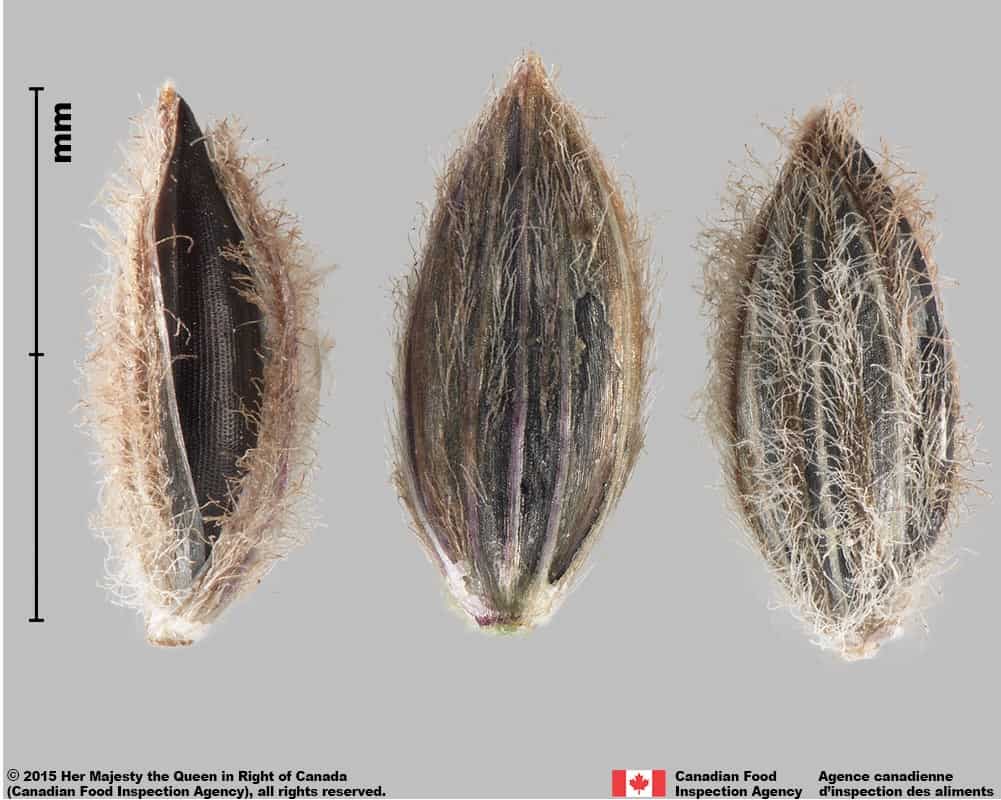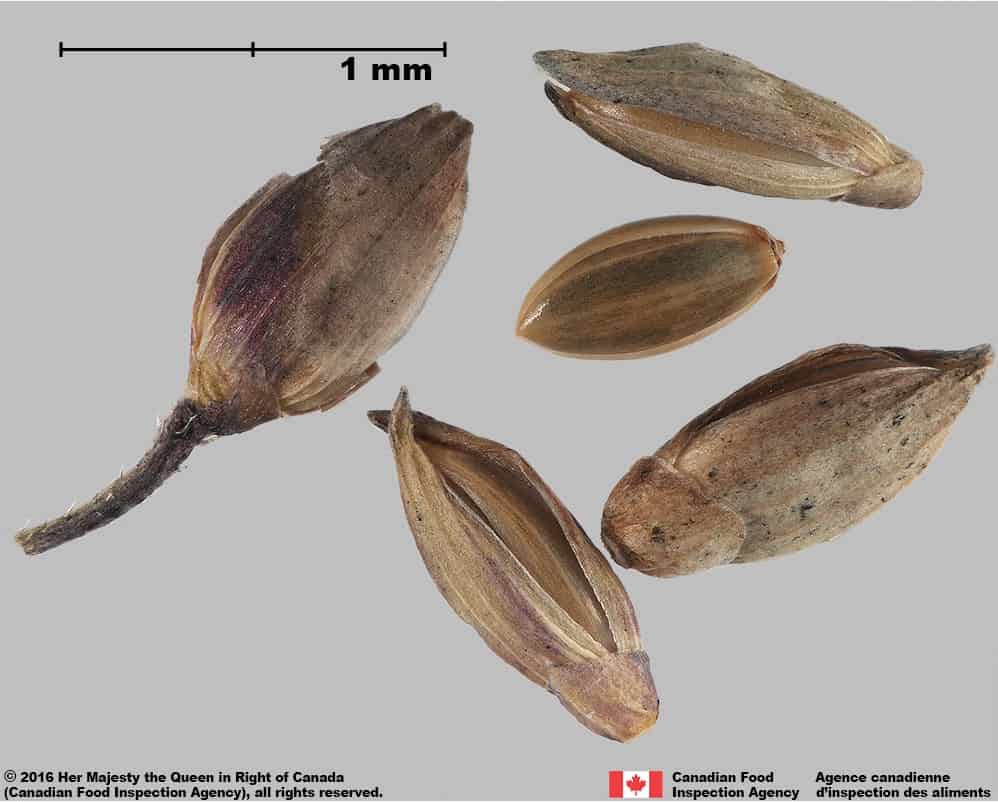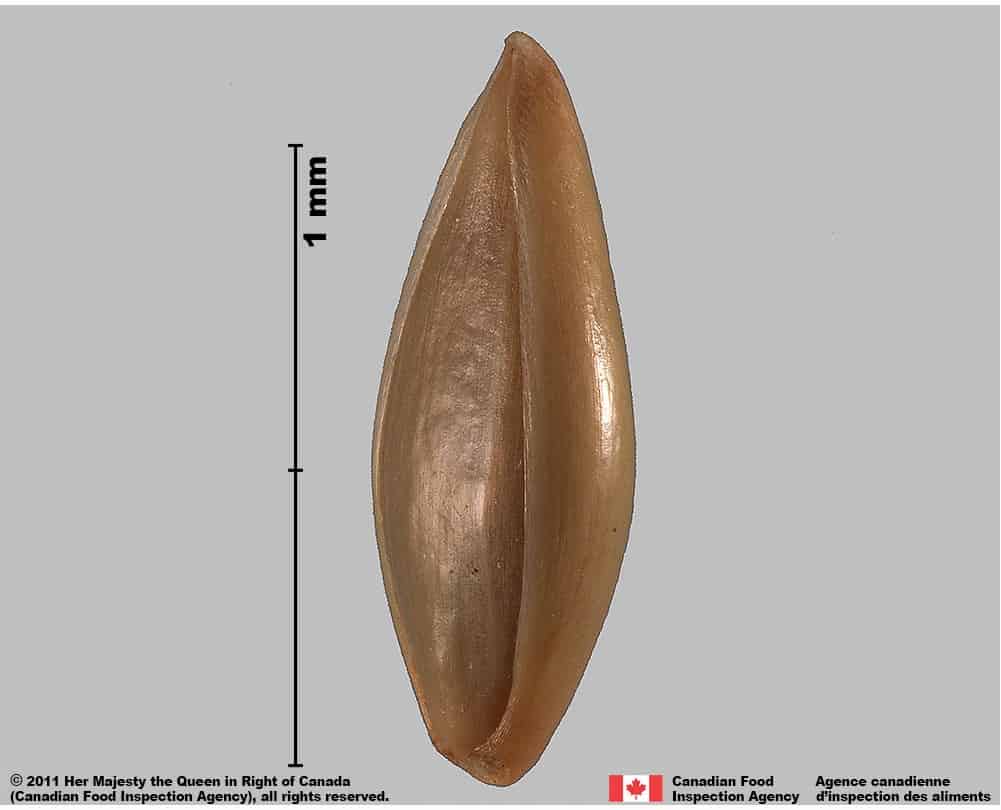Digitaria
Explore More :
Explore plus :
Overview
Aperçu
Regulation :
Remarques Réglementation:
- CFIA Weed Seeds Order - Class 4: Secondary Noxious Weed Seeds
- CFIA Weed Seeds Order - Class 5: Noxious Weed Seeds
Regulation Notes:
Distribution :
Répartition :
The genus contains about 250 species originating from tropical and warm temperate parts of the world (Mabberley 2008). It includes cultivated and weedy species, some widely introduced around the world (USDA-ARS 2021). The genus includes 29 species that occur in North America (Barkworth et al. 2003), species distributed across Canada with the exception of Newfoundland and the territories (Brouillet et al. 2010+).
Habitat and Crop Association :
Habitat et Cultures Associées :
Cultivated fields, pastures, gardens, lawns, orchards, vineyards, shores, roadsides, railway lines and disturbed areas (Darbyshire 2003; CABI 2021). Weedy species infest a variety of crop fields worldwide and are problematic in lawns (CABI 2021).
Economic Use, cultivation area, and Weed Association :
Utilisation économique, zone de culture et association de mauvaises herbes :
Duration of Life Cycle :
Durée du cycle vital:
Most species annual; some perennial
Dispersal Unit Type :
Type d’unité de dispersion :
Spikelet
General Information
RENSEIGNEMENTS GÉNÉRAUX
Of the 29 Digitaria species distributed in North America, 18 are native to the area and the rest are introduced weeds (Barkworth et al. 2003). The species occurring in Canada are: the introduced species Digitaria sanguinalis (large crabgrass) and D. ischaemum (smooth crabgrass ) and the native species D. cognata (fall crabgrass ) (Darbyshire 2003; Brouillet et al. 2010+).
Digitaria species are known mostly as problem weeds in sandy and loam soils (Darbyshire 2003; CABI 2021). Large Digitaria species plants can generally produce 150,000 seeds in a growing season and mature plants spread over large areas by tillering soon after establishment (CABI 2021).
.
Digitaria spp. seedling (Joseph M. DiTomaso, University of California – Davis, Bugwood.org)
Identification
Identification
-
Spikelet
Size
- Size of spikelets of Digitaria species are variable, ranging from 1.2 – 8.2 mm long (Barkworth et al. 2003)
- The most commonly encountered weedy species in North America are D. sanguinalis and D. ischaemum (Barkworth et al. 2003)
- D. ischaemum spikelet length: 1.7 – 2.3 mm (Barkworth et al. 2003)
- D. sanguinalis spikelet length*: 2.1 – 2.9 mm; width: 0.8 – 1.0 mm
*Note: minimum and maximum of 10 spikelets in a normal range of this species using image measurement (ISMA 2020)
Shape
- Digitaria species spikelets are short or long oval-shaped, compressed in edge view
Surface Texture
- Digitaria species spikelets are generally hairy with several longitudinal nerves
Colour
- Spikelets are dull straw-yellow or light green
Other Features
- The glumes are generally triangular shaped and can partially or completely cover the floret depending on the species
- The sterile lemma completely covers the palea side of the fertile floret in all Digitaria species

Smooth crabgrass (Digitaria ischaemum) spikelets










-
Floret
Size
- Floret size same as the spikelet size
Shape
- Florets oval shaped, compressed in edge view
Surface Texture
- Florets appear to have smooth surfaces, but are pitted in longitudinal lines under high magnification
Colour
- Florets are generally shiny brown or greenish-brown coloured, some species are black
Other Features
- Lemmas have distinctive thin, translucent margins that wrap around the palea, covering the edges
- Palea teeth are not visible

Large crabgrass (Digitaria sanguinalis) spikelets, florets and caryopses

-
Caryopsis
Size
- Caryopsis length similar to floret length
Shape
- Caryopsis is oval shaped, compressed in edge view
Surface Texture
- Caryopsis has a smooth surface
Colour
- Caryopsis is translucent shiny white or light brown coloured
Other Features
- Caryopsis has a dark brown round or oval hilum near the end of the caryopsis, opposite the embryo side

Large crabgrass (Digitaria sanguinalis) spikelets, florets and caryopses

-
Embryo
Size
- Embryo is a rudimentary size compared to the caryopsis
Shape
- Embryo is oval shaped, in a lateral position, at an end of the caryopsis on one side
Endosperm
- Endosperm is hard and translucent, almost colourless
Other Features
- Embryo is up to ½ the length of the caryopsis (Barkworth et al. 2003)
Identification Tips
CONSEILS POUR L’IDENTIFICATION
Genera from the same tribe as Digitaria species, the Paniceae, have certain features that distinguish them from other tribes in the Poaceae:
- Shed as a spikelet
- Spikelets have papery, unequal glumes, a papery sterile floret and a hard, shell-like or leathery fertile floret
- Florets lack a rachilla or pedicels
- Inconspicuous palea teeth
- Florets tend to be short oval rather than elongate
Within the Paniceae tribe, Digitaria species have distinguishing features:
- Triangular glume partially covering the lemma in some species
- Florets with a pitted surface in longitudinal lines
- Florets are black in some species
- Callus not visible
Additional Botany Information
AUTRES RENSEIGNEMENTS BOTANIQUES
Similar Species
ESPÈCES SEMBLABLES
Similar species are based on a study of seed morphology of various species, and those with similar dispersal units are identified. The study is limited by physical specimen and literature availability at the time of examination, and possibly impacted by the subjectivity of the authors based on their knowledge and experience. Providing similar species information for seed identification is to make users aware of similarities that could possibly result in misidentification.
Panicum spp. L. (panic grasses)
Panicum species are generally inflated in side view, spikelets are not hairy, glumes cover the floret, florets are smooth, glossy brown or yellow coloured with a striped colour pattern. Digitaria species spikelets are generally compressed in side view, glumes are hairy and partially cover the floret, florets with pitting, and a shiny brown colour in comparison.
Click to select species
Cliquez pour sélectionner les espèces

Panicum antidotale

Panicum capillare

Panicum dichotomiflorum

Panicum virgatum
Comparison Window
Fenêtre de comparaison
MAIN SPECIES
ESPÈCES PRINCIPALES
Digitaria

Digitaria
Poaceae
Smooth crabgrass (Digitaria ischaemum) spikelets
MAIN SPECIES
ESPÈCES PRINCIPALES
Digitaria

Digitaria
Poaceae
Smooth crabgrass (Digitaria ischaemum) spikelet
MAIN SPECIES
ESPÈCES PRINCIPALES
Digitaria

Digitaria
Poaceae
Smooth crabgrass (Digitaria ischaemum) spikelet
MAIN SPECIES
ESPÈCES PRINCIPALES
Digitaria

Digitaria
Poaceae
Large crabgrass (Digitaria sanguinalis) spikelets
MAIN SPECIES
ESPÈCES PRINCIPALES
Digitaria

Digitaria
Poaceae
Large crabgrass (Digitaria sanguinalis) spikelets
MAIN SPECIES
ESPÈCES PRINCIPALES
Digitaria

Digitaria
Poaceae
Large crabgrass (Digitaria sanguinalis) spikelet, outer side
MAIN SPECIES
ESPÈCES PRINCIPALES
Digitaria

Digitaria
Poaceae
Large crabgrass (Digitaria sanguinalis) spikelet, inner side
MAIN SPECIES
ESPÈCES PRINCIPALES
Digitaria

Digitaria
Poaceae
Large crabgrass (Digitaria sanguinalis) spikelets, florets and caryopses
MAIN SPECIES
ESPÈCES PRINCIPALES
Digitaria

Digitaria
Poaceae
Southern crabgrass (Digitaria ciliaris) spikelets
MAIN SPECIES
ESPÈCES PRINCIPALES
Digitaria

Digitaria
Poaceae
Southern crabgrass (Digitaria ciliaris) spikelet
MAIN SPECIES
ESPÈCES PRINCIPALES
Digitaria

Digitaria
Poaceae
Southern crabgrass (Digitaria ciliaris) spikelet
SIMILAR SPECIES
ESPÈCES SEMBLABLES
Panicum antidotale

Panicum antidotale
Poaceae
Blue panic grass (Panicum antidotale) florets
SIMILAR SPECIES
ESPÈCES SEMBLABLES
Panicum antidotale

Panicum antidotale
Poaceae
Blue panic grass (Panicum antidotale) florets
SIMILAR SPECIES
ESPÈCES SEMBLABLES
Panicum antidotale

Panicum antidotale
Poaceae
Panicum antidotale floret
SIMILAR SPECIES
ESPÈCES SEMBLABLES
Panicum antidotale

Panicum antidotale
Poaceae
Panicum antidotale floret
SIMILAR SPECIES
ESPÈCES SEMBLABLES
Panicum antidotale

Panicum antidotale
Poaceae
Blue panic grass (Panicum antidotale) floret
Need ID Help?
Besoin d’aide pour l’identification?
Reference(s)
Référence(s)
Barkworth, M. E., Capels, K. M., Long, S., Anderton, L. K. and Piep, M. B., (eds.) 2003. Volume 25. Magnoliophyta: Commelinidae (in part): Poaceae, part 2. Oxford University Press, New York, New York.
Brouillet, L., Coursol, F., Meades, S. J., Favreau, M., Anions, M., Bélisle, P. and Desmet, P. 2010+. VASCAN, the database of vascular plants of Canada. http://data.canadensys.net/vascan/ Accessed March 23, 2021.
Centre for Agriculture and Bioscience International (CABI). 2021. Invasive Species Compendium, CAB International, Wallingford, UK. https://www.cabidigitallibrary.org/journal/cabicompendium Accessed March 23,2021.
Darbyshire, S. J. 2003. Inventory of Canadian Agricultural Weeds. Agriculture and Agri-Food Canada, Research Branch. Ottawa, ON.
Global Biodiversity Information Facility (GBIF) Secretariat. 2022. https://doi.org/10.15468/39omei Accessed via https://www.gbif.org/species/2704525 Accessed December 29, 2022.
Government of Canada (GC). 2016. Canadian Weed Seeds Order. https://laws-lois.justice.gc.ca/eng/regulations/SOR-2016-93/page-2.html (English) https://laws-lois.justice.gc.ca/fra/reglements/DORS-2016-93/page-2.html (French)
International Seed Morphology Association (ISMA). 2020. Method for Seed Size Measurement. Version 1.0. ISMA Publication Guide. https://www.idseed.org/authors/details/method_for_seed_size_measurement.html
Mabberley, D. J. 2008. Mabberley’s plant-book: A portable dictionary of plants, their classification and uses (3rd eds). Cambridge University Press, Cambridge, UK. 1021 pp.
U.S. Department of Agriculture-Agricultural Research Services (USDA-ARS). 2021. Germplasm Resources Information Network (GRIN), https://npgsweb.ars-grin.gov/gringlobal/taxon/taxonomysimple.aspx Accessed March 23, 2021.
U.S. Department of Agriculture-Natural Resources Conservation Service (USDA-NRCS). 2022. The PLANTS Database. National Plant Data Team, Greensboro, NC USA. http://plants.usda.gov Accessed December 29, 2022.




